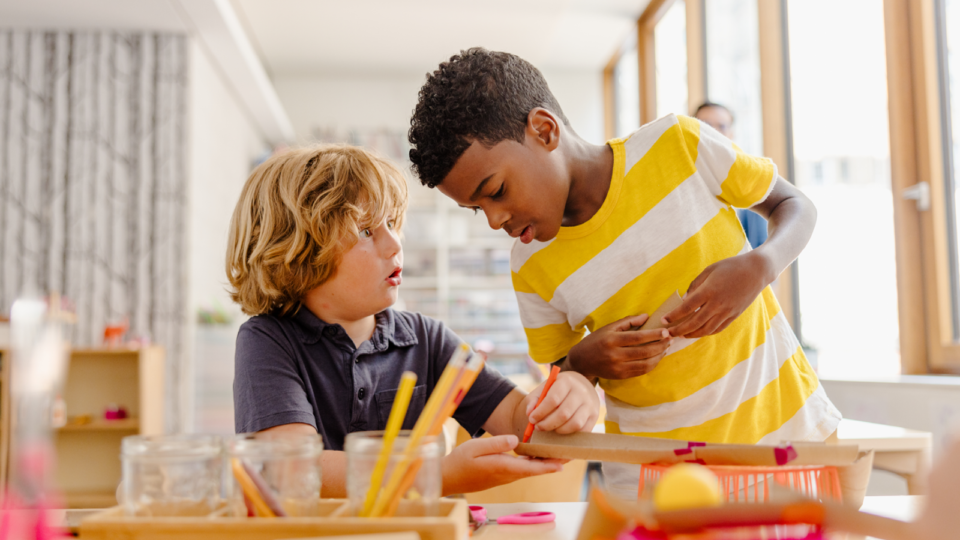
Every teacher has experienced that moment: a thought-provoking question followed by silence. One or two hands rise, if any.
Using the turn and talk strategy in the classroom can help change that dynamic. Rather than relying on volunteers to answer, this technique ensures every student has a voice by engaging them in brief, purposeful peer conversations. Research shows that frequent opportunities for peer dialogue expand understanding, consolidate thinking, and support mastery of new learning.
What is the turn and talk strategy?
Turn and talk is a classroom routine where students turn to a partner and respond to a prompt. It’s commonly used in literacy but works just as well in any subject.
This strategy transforms passive learning into active engagement. As students articulate their ideas, they refine their thinking, gain confidence, and learn from one another. Teachers can use it as a check for understanding strategy, a practice supported showing that classroom talk fosters disciplinary knowledge and cognitive skill building.
A typical turn and talk procedure:
- Pose an open-ended question.
- Signal students to turn to their partner.
- One student shares while the other listens.
- Have students switch roles.
- The class reconvenes for a brief discussion or transition.
Its strength lies in its immediacy and adaptability. No special materials are needed, just a thoughtful question and a classroom culture that values every student’s voice.
Turn and talk benefits
The benefits of turn and talk span cognitive, social, and emotional development. It supports content mastery while nurturing classroom community.
Academic benefits
- Clarifies thinking: Students process ideas out loud.
- Improves retention: Peer talk reinforces new concepts.
- Promotes metacognition: Learners reflect on their thinking.
Personal benefits
- Builds confidence: Students speak in a low-pressure setting.
- Encourages opportunity: Every student has a chance to contribute.
- Fosters belonging: Partner work creates consistent opportunities to connect.
In addition, turn and talk can support differentiated instruction. Teachers can adjust prompts for readiness levels or provide sentence frames as a scaffold. This flexibility makes it a great routine for reaching all students.
Turn and talk vs think-pair-share
Educators often compare turn and talk with the think-pair-share strategy, and while both involve peer discussion, the timing and structure differ.
Think-pair-share works well when a deeper dive or public sharing is the goal. Turn and talk works better for rapid, inclusive engagement during instruction.
Turn and talk:
- Begins directly with partner conversation.
- Skips the silent reflection and whole-group component.

Think-pair-share:
- Think: Students pause to reflect silently.
- Pair: They discuss their thinking with a partner.
- Share: Ideas are shared with the whole class.

How to teach the turn and talk strategy
Like any effective routine, turn and talk strategies needs to be explicitly taught and consistently reinforced.
Turn and talk expectations
Establish clear norms:
- Face your partner.
- Take turns speaking and listening.
- Stay focused on the prompt.
- Use respectful, academic language.
Anchor charts and consistent modeling help solidify these expectations.
Download this free anchor chart for helpful classroom tips on how to respectfully speak and listen to one another.

Turn and talk protocol
Structure builds success. Assign partners ahead of time and establish clear signals to begin and end discussions, such as a hand clap, ringing a bell, or a verbal cue like “Turn and talk to your partner for 30 seconds—go!” Visual cues, including a thumbs-up or a “thinker’s pose,” can also help students know when to start or share. After the discussion, build in reflection time so students can process and record their ideas.
Use sentence frames to support language development and academic discourse. For example, students might say, “I think ___ because ___,” “My partner said ___, and I agree/disagree because ___,” or “One strategy I used was ___.” These frames help all learners, especially multilingual students, express their thinking clearly and confidently.
Download this free anchor chart for helpful classroom tips on having collaborative conversations

Turn and talk example questions and prompts
Strong questions are central to effective turn and talk. Choose open-ended prompts that invite interpretation, reasoning, and connection.
Here are a few subject-specific examples:
- Literacy: “Why do you think the character made that choice?”
- Math: “How did you solve this problem?”
- Science: “What evidence supports your conclusion?”
- Social Studies: “How might this event affect people today?”
Aim for prompts that spark curiosity and push students to explain or justify their ideas.
Is turn and talk a formative assessment?
The turn and talk strategy can be an accessible type of formative assessment. Listening to student conversations offers immediate insight into their thinking. Teachers can use this data to identify misconceptions, adjust instruction, or reinforce concepts on the spot.
To maximize the assessment value:
- Circulate actively: Listen in to assess understanding.
- Use strategic prompts: Ask questions that reveal reasoning.
- Follow up: Invite reflection or quick writing to capture ideas.
Because turn and talk is embedded in instruction, it doesn’t disrupt the flow of learning and doesn’t require formal grading.
Turn and talk rubric
Consider using a simple rubric to assess key elements, such as:
- Engagement: Did the student participate actively?
- Listening: Did they show attention to their partner’s ideas?
- Clarity: Was their response thoughtful and relevant?
Rubrics don’t need to be complex. Tracking a few targeted criteria in a rubric aligned to the learning goals can help guide the feedback given and better support the student's growth.

Turn and talk in practice
The turn and talk strategy is woven into many instructional programs, providing built-in support and structure.
- HMH Into Reading: Turn and talk is embedded in read-alouds, vocabulary work, and essential question discussions. Sentence frames and visual supports scaffold conversations.
- HMH Into Math: Students use turn and talk to discuss strategies, compare solutions, and explain their thinking during problem solving.
- Classcraft: AI tools capture student responses after partner discussions, offering teachers insights into student thinking and supporting formative assessment. Watch this video to see how AI generates a summary of a classroom discussion in Classcraft.
While programs like these can provide a framework, the strategy is versatile. Any teacher can implement turn and talk in the classroom, adapt it, and make it a meaningful part of daily instruction.
***
Discover a proven path to reading and writing success for students in Grades K–6 with HMH Into Reading.
Get our free guide to differentiated instruction.














